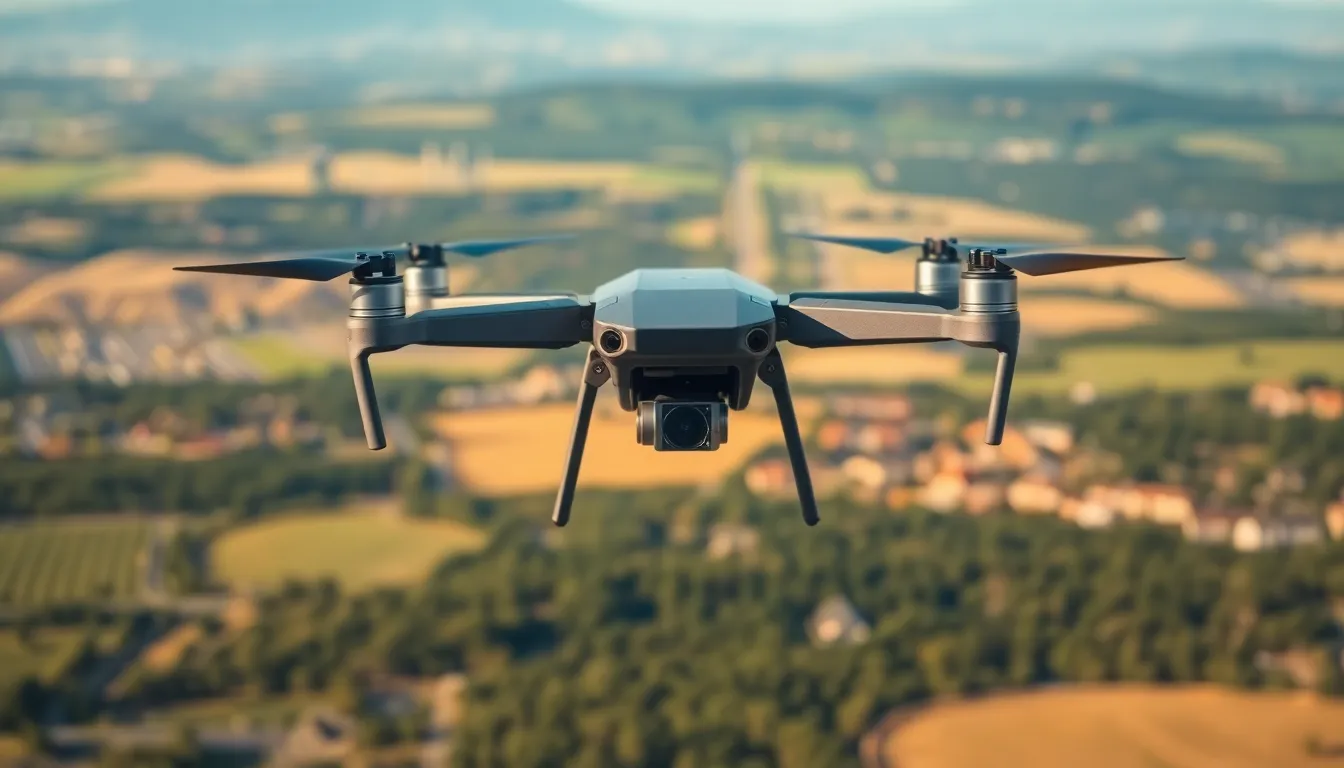In a world where everyone’s a photographer, drone cameras are the new superheroes soaring above the ordinary. With features that make even the most seasoned pros envious, these flying gadgets are transforming the way people capture life’s moments. Imagine gliding through the sky while snapping breathtaking aerial shots that leave friends and followers in awe.
Table of Contents
ToggleOverview of Drone Camera Features
Drone cameras boast various features that enhance aerial photography. High-resolution sensors capture stunning details in images and videos. Typically, models offer resolutions of 12 MP to 48 MP, providing options for diverse photography needs.
Gimbal stabilization improves flight performance. This feature minimizes the shakes and jitters common in aerial footage, ensuring steady results. Many drones include 3-axis gimbals, optimizing video quality during flight.
Equipped with different camera types, drones cater to various filming scenarios. Some models offer dual-camera systems, combining optical and thermal imaging for versatility. Advanced lenses further enhance the quality, enabling users to capture wide-angle or zoomed shots.
Automated flight modes simplify complex maneuvers. Features like Follow Me, Waypoints, and Orbit enhance the pilot’s experience while capturing dynamic shots. These modes can adapt to different settings, from landscapes to events, thus catering to different photography styles.
Incorporating live streaming capabilities makes sharing content instantaneous. Users can broadcast high-definition video in real-time, ideal for events or live broadcasts. Various drones support high-speed data transfer, allowing quick updates to social media platforms.
Extended flight times also create more opportunities for capturing the perfect shot. Many drones now feature flight durations of up to 30 minutes on a single charge. Battery management systems ensure efficient energy use, prolonging the time spent in the air.
Overall, drone camera features continuously evolve, appealing to photographers seeking innovative tools. High-quality sensors, stabilization systems, versatile cameras, and automated modes collectively push the boundaries of aerial photography.
Types of Drone Cameras

Different categories exist for drone cameras, each designed to address specific user needs and preferences.
Consumer Drones
Consumer drones often feature lightweight bodies and user-friendly interfaces. Most models come with cameras ranging from 12 MP to 20 MP, enabling users to capture stunning photos and videos easily. Gimbal stabilization, commonly found in these drones, helps produce smooth footage even in windy conditions. Many consumer drones support automated flight modes, allowing operators to enjoy a stress-free flying experience. Enhanced battery life typically offers flight times of around 20 minutes, making it convenient for short recreational outings. Various mobile applications enhance usability through real-time monitoring and editing tools, further appealing to amateur photographers.
Professional Drones
Professional drones cater to photographers who demand the highest quality images and advanced functionality. These devices frequently sport high-resolution sensors, often exceeding 20 MP, to capture intricate details. A typical feature set includes dual-camera systems enabling diverse shooting perspectives. Gimbal stabilization is integral here, ensuring every frame remains steady during dynamic movements. Extended flight times of up to 30 minutes provide ample opportunity to capture diverse shots in a single flight. Furthermore, professionals benefit from advanced capabilities like live streaming, allowing for immediate content sharing from unique vantage points.
Key Features to Consider
When selecting a drone camera, several critical features significantly impact performance and user experience. Understanding these aspects can help photographers make informed choices.
Camera Resolution
Camera resolution determines the quality of images captured. Drone cameras commonly feature resolutions ranging from 12 MP to 48 MP. Enhanced resolution provides finer details, making images crisp and suitable for large prints. High-resolution sensors excel in varying lighting conditions, which benefits photographers seeking versatile shooting opportunities. Advanced cameras often include options for RAW format, allowing for greater editing flexibility.
Gimbal Stabilization
Gimbal stabilization plays a vital role in ensuring smooth footage. This feature counteracts vibrations and movements during flight, resulting in professional-looking videos. Most drones utilize 2-axis or 3-axis gimbal systems, with 3-axis gimbals delivering superior stability by maintaining the camera’s horizontal and vertical position. Users benefit from fewer shaky shots, especially in dynamic or windy conditions. A reliable gimbal enhances both drone photography and videography experiences.
Flight Time and Range
Flight time and range are crucial for uninterrupted shooting. Many consumer drones offer flight times of around 20 minutes, while professional models extend beyond 30 minutes. Longer flight durations allow photographers to capture more content without frequent landings. Additionally, flight range varies significantly, with some drones exceeding 4 miles, facilitating expansive aerial exploration. Photographers gain flexibility in navigating diverse landscapes and capturing stunning visuals from elevated perspectives.
Advanced Features
Advanced features in drone cameras significantly enhance user experience and photographic quality. These capabilities elevate the performance of drone cameras, making them invaluable tools for both amateurs and professionals.
Obstacle Avoidance
Obstacle avoidance technology improves safety during flight. Drones equipped with this feature utilize sensors to detect and navigate around obstacles. These sensors may include ultrasonic, infrared, or visual recognition systems, which work together to create a three-dimensional map of the surrounding area. As a result, drones can autonomously adjust their flight path. This functionality minimizes the risk of crashes and provides peace of mind, especially in complex environments. Photographers can focus on capturing stunning aerial shots without worrying about potential hazards.
Live Streaming Capabilities
Live streaming capabilities enable real-time sharing of high-definition footage. Features such as 4K resolution streaming offer crystal-clear visuals for viewers. Drone cameras with this technology can connect to various platforms, allowing for seamless broadcasting of events or scenic landscapes. Users can engage audiences directly during aerial photography sessions. This feature enhances opportunities for creative storytelling and immediate feedback from viewers. The ability to live stream has transformed how events are documented, making drone footage more accessible and engaging.
Drone cameras have revolutionized the world of photography by offering innovative features that cater to a wide range of users. With advanced capabilities like high-resolution sensors and gimbal stabilization, they enable stunning aerial shots that were once difficult to achieve.
The growing variety of consumer and professional drones ensures that everyone can find a model suited to their needs. Features like automated flight modes and live streaming further enhance the user experience, making it easier than ever to capture and share breathtaking moments.
As technology continues to advance, drone cameras will undoubtedly push the boundaries of creativity and exploration in photography, allowing photographers to document the world from new and exciting perspectives.










